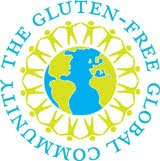When Trish from Kinda Real Gluten Free Food came to me with her post, she knew it was a little different than what we normally share here on the Healthy Lunchbox series. Even so, she covers a very vital topic of understanding the rules and regulations your schools must follow in regard to dealing with allergies and providing gluten-free foods for children with celiac disease. I cannot thank Trish enough for jumping in with this fantastic and vital information.
_________________________________________________________________________________________
Kids Have Rights, Too: Sending Your Gluten-Free Child Back to School
 |
| image courtesy muchadoaboutfooding.com |
Must your school provide gluten-free options for your child with celiac disease? Maybe. In a recent settlement with Lesley University in Massachusetts, the Justice Department ruled that the college must offer gluten-free food choices to students with celiac disease. According to the ruling, severe food allergies may be considered a disability under the ADA (Americans with Disabilities Act.) That judgement makes sense, especially since the college requires its students to be on the meal plan. But what about younger kids? Do the same rules apply?
The U.S. Department of Agriculture’s (USDA) regulation concerning non-discrimination and the directives of the National School Lunch and Breakfast Programs all confirm that substitutions must be made for kids whose disabilities make them unable to eat the regular meal. According to the USDA, “substitutions to the regular meal must be made for children who are unable to eat school meals because of their disabilities, when that need is certified by a licensed physician.”
Seems pretty cut and dried, right? Your kid can’t eat the cafeteria food, so the school should provide food they can eat. Maybe in the future, but right now public schools don’t necessarily have to change anything, unless it is specified in the student’s Individualized Education Plan (IEP) and/or his or her 504 plan (which is a document detailing modifications a child would need in order to have the same opportunities at school as their peers.) Many schools are happy to accommodate all of their students, but having those accommodations in writing can be vitally important. (Private and parochial schools are not held to the same standards as schools that receive federal funding.)
What should you do?
If you decide that you want to go forward, start with a conversation with your child’s doctor, explaining your goals. In order to bring the diagnosis to the school’s attention, you need to have it in writing. In most schools, a simple letter from the physician stating the following is sufficient:
- The disability
- Why the disability requires dietary restriction
- The “life activity” affected
- Which foods must be omitted
- Which foods may be substituted
Next, call your child’s school’s guidance department and request a 504 meeting. If your child is already enrolled in special education, you would speak to his or her case manager about adding a health plan to the IEP.
The meeting should be attended by you (the parents), the primary teacher (if your child is in elementary school), school counselor, the school nurse, the director of food services or dietitian and possibly a school administrator. Remember that all of these people care about educating your child; they are not “the enemy” and you are not trying to get something over on them. You want your child’s experience to be like all the other kids’. Try not to feel like a victim (or that your child is); be a partner and calmly discuss your concerns. Keep in mind that while you are concerned with feeding one or two children at the school, they have hundreds to feed! (It’s not reasonable to expect them to hire a personal chef for your kid.) It is not required that the accommodation or substitution be identical to the original (non GF) item.
There are non-cafeteria situations, like field trips and classroom parties, that should also be addressed at the meeting. Remember, especially if your child is very young, that art and other classes may use materials containing gluten, such as play dough, paste, noodles, oatmeal – even the adhesive on envelopes may contain gluten! In fact, some cleansers, soaps and hand sanitizers are made with wheat derivatives.
It may seem easier to simply pack your child’s lunch or start homeschooling when you think of all of the possibilities for gluten exposure, but you don’t need to keep your kids in a bubble. You pay taxes and if your child attends public school, he or she is entitled to a school experience like every other student’s, including eating lunch safely in the cafeteria. (And if your child qualifies for free or reduced cost meals, the gluten-free foods he or she eats at school can save you money.)
The day may come when all schools offer options for students who need a special diet, but until then, you can speak up for your child and make a change. After all, while they’re young, you are your kid’s best advocate. And who knows? You might make it easier for the next student with celiac disease.
Helpful links:
The NFCA (National Foundation for Celiac Awareness) has prepared a 504 Plan Roadmap to help you when you meet with your child’s school.
Sample doctor letter from American Celiac Disease Alliance
Sample menu from Lincoln Public Schools (Nebraska), which offers gluten-free options















[…] away at school, Trish from Kinda Real Gluten Free Food brought us a wealth of information regarding USDA regulations concerning non-discrimination and the directives of the National School Lunch and B…. Knowing the laws that protect your food allergy children are vital to their long-term success, […]